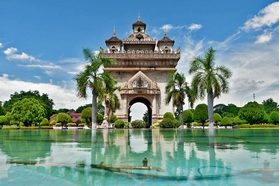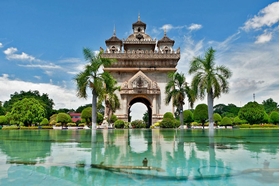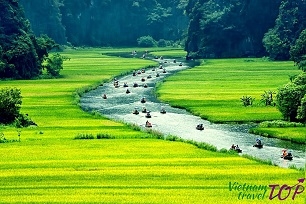Famous throughout the Southeast Asian backpacking world for its river tubing, Vang Vieng also happens to lie in the middle of an amazing karst landscape in central Laos that offers visitors a blue lagoon, amazing caves and beautiful waterfalls. Nevertheless, it’s the tubing that draws large numbers of young visitors looking to enjoy one of the largest party scenes in Southeast Asia.
When to go to Vang Vieng
Like most of Southeast Asia, Vang Vieng is incredibly hot for much of the year. Most travellers would say that the best time of year to visit Vang Vieng is during November-March, which is the dry and cool (or rather, less hot) season in Laos. March-May is the hottest time of year, and rainy season is approximately May-October.
Where to stay in Vang Vieng
Accommodation in Vang Vieng is generally inexpensive and easy to find; booking ahead is not always necessary, as it’s usually possible to find cheap, available hostels and guesthouses upon arrival. Especially if you’re staying on a super low budget, you may want to actually see your room before paying for it, just to ensure that you’re satisfied with the level of cleanliness and other amenities.
As Vang Vieng’s reputation has been broadening from its party vibe to become more inclusive of calmer travellers, so too has the range of accommodation within the town broadened.
Cheap hostels and guesthouses are still the most popular form of accommodation here, but slightly nicer, mid-range boutique hotels and guesthouses are popping up around town as more tourists come to Vang Vieng. Free wi-fi is generally available at most accommodation.
If you’re looking for a social atmosphere, it’s easy to make friends among other backpackers at many of the hostels and guesthouses in Vang Vieng; however, quieter accommodations are also available.
Where to eat in Vang Vieng
There are plenty of restaurants in Vang Vieng, but tourism in Vang Vieng has certainly had its effect on the types of foods available within the stalls and restaurants around the town – i.e., there’s quite a lot of Western food available here, and a somewhat limited selection of Laotian food.
The restaurants in Laos have a reputation for having nearly identical menus from location to location, and pizzas, burgers, and chicken sandwiches are fairly ubiquitous. However, most restaurants do also offer a limited variety of Laotian food as well. Noodle soups are common, as are fried pancakes/crepes.
Laap, a spicy minced meat salad, is a traditional dish Thai/Lao dish that you’ll definitely want to try if you’re looking to maximize the authenticity of your eating experience in Vang Vieng. Otherwise, you’ll probably have to leave the town to truly get a taste of traditional Lao food.
How to get around Vang Vieng
Vang Vieng is a small town, so it’s easy to navigate the town by foot, and get to everywhere you need.
If you’d like to move a little faster, bicycles are usually available for daily rentals from hotels or other small businesses, generally running about 20,000 kip per day. There are also plenty of tuk-tuks within the town, and most tuk-tuk rides within the actual town of Vang Vieng will only cost about 10,000 kip.
Tuk-tuks can also be rented for a day, which can be a good way to get out and about to surrounding attractions outside of the town centre of Vang Vieng itself, and the price for this will most likely vary depending on where you want to go within the day/how far apart the places are. Just be sure to prearrange a suitable price with your tuk-tuk driver for the day.
Another way to get around is through motorbike rental, and a small, automatic scooter will likely cost you about 40,000-60,000 kip for a day’s rental—higher cc bikes may run as much as 200,000 kip per day. Motorbikes are a great way for independent exploration, but it is important to be aware of traffic at all times and drive safely and responsibly.
How to get to and from Vang Vieng
Vang Vieng lies in between Vientiane (the current capital city of Laos) and Luang Prabang (the royal capital of the country until 1975), and is easily accessible by bus from either city (approximately 3-4 hours to get to Vang Vieng from Vientiane and about 6-8 hours to get there from Luang Prabang).
Bus or minivan from either Luang Prabang or Vientiane is, by far, the most common way for tourists to get into Vang Vieng. Bus tickets are readily available for purchase at hotels, guesthouses, and travel agents all around in both Vientiane and Luang Prabang.
Minivan tickets are also an option, and these drivers are generally able to travel a bit faster than the larger buses. Prices will vary depending on which option you choose; minivans from Luang Prabang will cost upwards of 120,000 kip while slower local buses will cost around 90,000 kip (this ticket may cost more if purchased through a guesthouse or hotel that also includes transport to the bus station).
Prices for buses from Vientiane to Vang Vieng are a bit cheaper, due to the shorter distance covered; expect to pay within the range of 50,000-100,000 kip, depending on whether you take a bus or minivan.
Buses from elsewhere in the country (or neighbouring countries) will probably require a stop/transfer in Vientiane or Luang Prabang before getting to Vang Vieng. It is also possible to get a taxi from Vientiane to Vang Vieng, which will generally take about 3.5 hours (depending on traffic or other stops), but you’ll have to pay a pretty penny for it—over 700,000 kip.
Money Saving Tips
Vang Vieng is one of the cheaper places in Laos and you will be hard pressed to spend a lot of money here, even if you go out drinking every night.
















